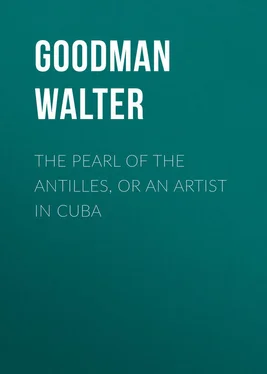Walter Goodman - The Pearl of the Antilles, or An Artist in Cuba
Здесь есть возможность читать онлайн «Walter Goodman - The Pearl of the Antilles, or An Artist in Cuba» — ознакомительный отрывок электронной книги совершенно бесплатно, а после прочтения отрывка купить полную версию. В некоторых случаях можно слушать аудио, скачать через торрент в формате fb2 и присутствует краткое содержание. Жанр: foreign_antique, foreign_prose, Путешествия и география, на английском языке. Описание произведения, (предисловие) а так же отзывы посетителей доступны на портале библиотеки ЛибКат.
- Название:The Pearl of the Antilles, or An Artist in Cuba
- Автор:
- Жанр:
- Год:неизвестен
- ISBN:нет данных
- Рейтинг книги:4 / 5. Голосов: 1
-
Избранное:Добавить в избранное
- Отзывы:
-
Ваша оценка:
- 80
- 1
- 2
- 3
- 4
- 5
The Pearl of the Antilles, or An Artist in Cuba: краткое содержание, описание и аннотация
Предлагаем к чтению аннотацию, описание, краткое содержание или предисловие (зависит от того, что написал сам автор книги «The Pearl of the Antilles, or An Artist in Cuba»). Если вы не нашли необходимую информацию о книге — напишите в комментариях, мы постараемся отыскать её.
The Pearl of the Antilles, or An Artist in Cuba — читать онлайн ознакомительный отрывок
Ниже представлен текст книги, разбитый по страницам. Система сохранения места последней прочитанной страницы, позволяет с удобством читать онлайн бесплатно книгу «The Pearl of the Antilles, or An Artist in Cuba», без необходимости каждый раз заново искать на чём Вы остановились. Поставьте закладку, и сможете в любой момент перейти на страницу, на которой закончили чтение.
Интервал:
Закладка:
The musical entertainments begin with a performance on the piano by a sun-burnt young lady attired in a low-necked, short-sleeved dress, who accompanies another young lady who essays a patriotic song commencing:
in which she assures her audience, in Spanish verse, that there is no place like Cuba, and no country more fertile and picturesque than the Pearl of the Antilles. This favourite ditty is called a Melopea, or words without a melody – the words being simply 'spoken,' and closely followed on the piano by lively music.
This song and another having been disposed of, partners are selected and the Danza Criolla – a popular Cuban valse – is for the rest of the afternoon (for it is still broad daylight) performed. The guests then depart; and after a little conversation with Don Benigno and his family, Nicasio and I are conducted by a black domestic to our dormitories. Here we indulge in a siesta, and otherwise refresh ourselves till the hour of dinner.
Those of Nicasio's friends who have been foiled in their attempt to secure us for their guests, console themselves by exhibiting their hospitality in other ways. We are overwhelmed with invitations to pass the temporada, or season, at their estates in the country, and so numerous are these invitations that, were we to accept them all, two years would scarcely suffice for the fulfilment of our engagements.
During the first weeks of our residence in Santiago, the hospitality which we receive in various ways is sometimes overpowering. Wherever we may wander some unknown friend has anticipated our arrival, and secretly provided for our wants. We turn into a café for refreshments, and when we offer to pay for what we have ordered, the waiter refuses to take our coin, while he assures us that our repast has already been paid for! Subsequently we discover that the proprietors of all the restaurants and cafés in the town have been instructed by some mysterious person or persons not to accept payment from 'Don Nicasio Rodriguez y Boldú and his English companion,' but to 'put it down to the account.' Whenever we visit the theatre, the same pecuniary objections are raised; and upon one occasion, the haberdasher to whom we apply for a dozen shirts à la créole actually refuses to favour us with a bill!
These attentions are, however, short-lived, for my partner, after permitting them to exist for a reasonable length of time, publicly gives out that unless this overpowering hospitality altogether ceases, he and el Caballero Inglés will remove to a less demonstrative town. This warning takes effect, but still the tendency to 'stand treat' – which is a special weakness in Cuba – manifests itself in other ways.
I go into a café where some creoles – utter strangers to me – are grouped around one of the marble tables. If I happen to be accompanied by a lady, every man rises and salutes us. If alone, I am offered a seat and refreshments; for under no circumstances, and in no locality, does a Cuban eat and drink without first inviting his neighbours to partake of his fare. 'Usted gusta?' (Will you partake of this?) or 'Gusta usted tomar algo?' (Won't you take something?) is a Cuban's grace before meat.
These, attentions are not, however, confined to feeding. They are adapted to everything that a Cuban possesses. If I admire any article or individual belonging to a Cuban – no matter whether the object of my admiration be a watch-guard – a handsome cane – a horse – a gun – a slave, or a pretty child – I am invariably assured that it is mine (Es para usted), or that it is my servant (Un servidor de usted). When I ask a Cuban where he lives, he promptly replies: 'At your house,' in such-and-such a street, number so-and-so; and whenever such an individual favours me with a letter, I always find the document addressed: 'From your house' (Su casa).
In short, I never know what politeness means, nor what extensive West Indian possessions are at my disposal, till I live amidst the luxuries of the Pearl of the Antilles!
CHAPTER II.
DAILY LIFE IN CUBA
Like most of his neighbours, Don Benigno keeps 'open house' in more than one way. The huge street-door of his habitation remains unclosed at all hours of the day and evening, and anyone who pleases may walk in and partake of the Don's hospitality.
Don Benigno's house is constructed after the pattern of the good, old-fashioned Cuban dwellings, with an eye to earthquake, heavy rains, and excessive heat. So careful is a creole to provide against these casualties, that his residence serves less as an abode for comfort than as a place of shelter. It has a single storey, and is roofed with Roman tiles. The walls are of lath and plaster, or mamposteria, as it is called, and the beams which support the roof are visible from the interior as they are in a barn. Some of the apartments are paved with marble, while others are paved with brick. In the centre of the spacious reception-room, or sala, is laid a small square of carpet, like a misplaced hearth-rug, on which stand twelve rocking-chairs, arranged face to face like seats in a railway carriage. They are accompanied by a few footstools and some spittoons. The rooms are not overcrowded with furniture and ornaments, and these scarce commodities stand out in bold relief against the white-washed walls and bare flooring. The chairs and sofas are all cane-backed and cane-bottomed. Tables are not plentiful, and curtains are employed as adornments for some of the doors instead of the windows, which are also devoid of glass. An elegant gas chandelier is suspended from one of the cross-beams of the sloping roof, and a couple of unserviceable console tables, with their corresponding pier-glasses, complete the decorations of the sala.
No fire-stoves are required in any chamber except the kitchen, and the latter being situated in the patio, or court-yard, at the back of the premises, the residents in a Cuban house are never troubled with any other smoke than that which is generated by tobacco.
As for the dormitories – the one which I occupy might belong to a holy friar. There is an aspect of cell and sanctity about everything in it. The furniture is nothing to speak of, and the bed, which is called a catre, closely resembles a tressled apple-stall with a canvas tray. When not in use, the catre is shut up and whisked away into an obscure corner. When required for sleeping purposes, it is opened, and the bed having been 'made' with a couple of sheets and a pillow, it is planted in a cool place, which often happens to be the centre of the apartment.
The monotonous appearance of the white-washed walls is relieved by coloured lithograph drawings of saints and virgins, and against one of the walls is placed a table decorated like a small altar with a white lace-trimmed cloth upon which stand some gilded candlesticks, vases containing artificial flowers, and a large wooden statuette, gorgeously painted and embellished. This image represents the patron saint, Santiago, beneath whose feet burns night and day a small oil lamp. The object for which this luminary is intended is ignored by me for many days, and meanwhile I use it, when nobody is looking, for the lighting of my cigarettes. My authority for this sacrilegious act is derived from my companion, Nicasio, who is a liberal-minded Catholic, and as I find he also performs the same ceremony in his own dormitory, my conscience is relieved. Equally mysterious are a couple of dry fonts which have in all respects the appearances of china watch-pockets. I make use of one for the accommodation of my time-piece, until I am informed that only holy water is allowed to repose within its sacred embraces.
Читать дальшеИнтервал:
Закладка:
Похожие книги на «The Pearl of the Antilles, or An Artist in Cuba»
Представляем Вашему вниманию похожие книги на «The Pearl of the Antilles, or An Artist in Cuba» списком для выбора. Мы отобрали схожую по названию и смыслу литературу в надежде предоставить читателям больше вариантов отыскать новые, интересные, ещё непрочитанные произведения.
Обсуждение, отзывы о книге «The Pearl of the Antilles, or An Artist in Cuba» и просто собственные мнения читателей. Оставьте ваши комментарии, напишите, что Вы думаете о произведении, его смысле или главных героях. Укажите что конкретно понравилось, а что нет, и почему Вы так считаете.












